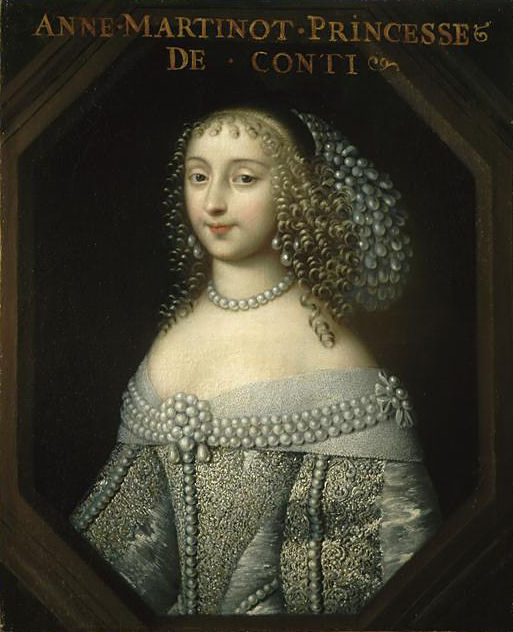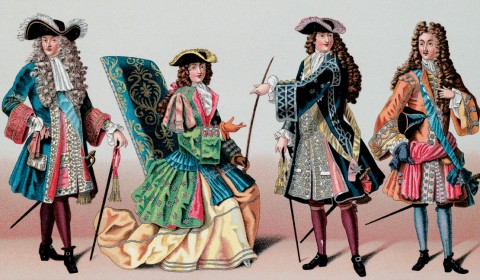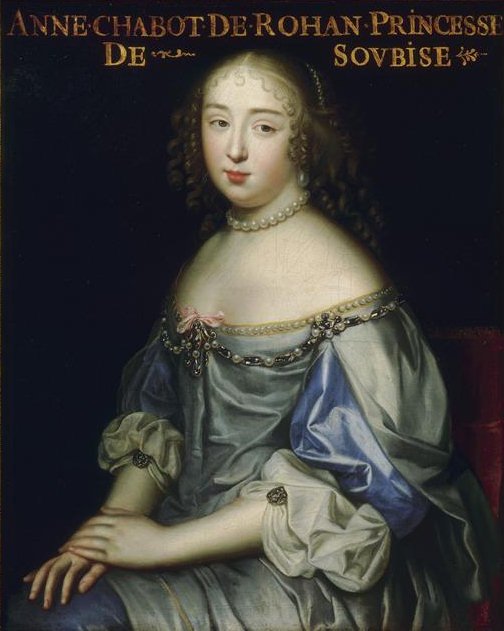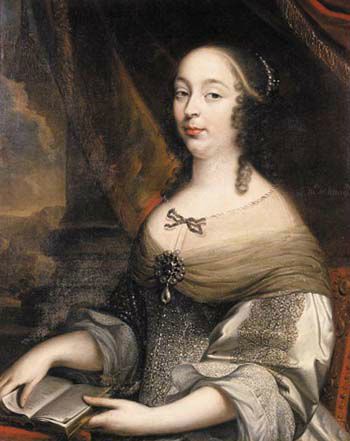Catherine Monvoisin, fortune teller, sorceress and poisoner
France was shaken by a scandal of enormous proportions in the late 1670’s, l’affaire des poisons, in its center the King, various women of the best noble families of France and a woman called La Voisin.

Catherine Deshayes was born around 1640 and married Antoine Monvoisin, sometimes spelled Montvoison. He was a jeweller with a shop at Pont-Marie, in the shadows of Notre Dame and not too far from the Louvre and the Hôtels of the noblesse. As her husband’s shop started to bring less profit, Catherine began to offer her services as midwife and, for coin, helped in case unwanted pregnancies. She also told the future, a talent she claimed God had given her.
She was taught the art of fortune-telling at the age of nine, and after her husband became ruined, decided to make a profit of it, by reading the client’s future in their faces and hands. Although witchcraft was largely dismissed by the educated as superstition and general nonsense, the Parisian lower classes still believed in things such as fortune-telling and potions, something Catherine began to include in her portfolio as well, upon noticing her clients wishes seemed to circle around the same issues. That someone would fall in love with them, that they wished to bind their straying lovers to them, the death of a spouse or enemy, the birth of a child, or the acquiring of a fortune.
In first, she only gave tips of how those wishes may become true, if it is also God’s wish, if the person in question visits a certain church on a certain day or prays to a specific Saint. Later, she also began to sell enchanted amulets and recommend magical practices of various kinds, along with her potions and powders. Some of those containing the bones of toads or powdered teeth of moles, iron filings, human blood and the dust of human remains, as well as Lytta Vesicatoria, the Spanish fly, perceived to have aphrodisiac properties… or if taken in a too high dose, being poisonous.
Catherine created quite the striving business, not only with her services, but also by providing the fitting surroundings for them in order to make her clients believe the things she was doing and mixing were actually working. She even acquired a robe of crimson red velvet embroidered with golden eagles worth 1,500 livres. A sum the normal Parisian could only dream of.
Madame Monvoisin became swiftly known for her aphrodisiacs and started to attract the better classes to her house at Villeneuve-sur-Gravois, which she had decorated especially for the purpose of performing her arts… like black masses. During at least some of these, a woman performed as an altar, upon which a bowl was placed and a baby was held above it, the baby’s blood dripping into the bowl. Catherine entertained her guests all day with music and refreshments in richly decorated salons or at night in the small private garden belonging to her house, in which she also buried the death babies, if they were not burned in a furnace. One accounts states that the bones of about 2500 death children were found there later on.
La Voisin’s fortune grew with the money of those that wished for a fortune themselves and her establishment at Villeneuve-sur-Gravois began to attract the noble women of Paris as well. Olympe Mancini, Comtesse de Soissons, allegedly paid for a poison meant for Louise de La Vallière. Her sister Marie Anne Mancini, Duchesse de Bouillon, allegedly planned to poison her husband in order to marry her nephew. The Comtesse de Gramont, Elizabeth Hamilton, was pointed out as a client and so were Marie-Louise-Charlotte-Claire d’Albert de Luxembourg, Princesse de Tingry, the Marchioness Benigne d’Alluye, Claude-Marie du Roure, the Comte de Clermont-Lodéve, Jacqueline Grimoard de Beaurevoir du Roure, Comtesse de Polignac, the Duchesse de Vivonne, the Marquis de Cessac, Marechal de la Ferthe, François-Henri de Montmorency, Duc de Luxembourg, and Madame de Motespan.
Madame Monvoisin supported a family of six with her work, including her mother and her lover, the magician Adam Lesage. Catherine had quite a few lovers, the executioner Andre Guillaume, Latour, the Vicomte de Cousserans, the Comte de Labatie, the alchemist Blessis, the architect Fauchet.

At one point, Adam Lesage tried to induce her to kill her husband by poisoning him, but she decided against it and aborted the process. She regularly attended the services of the Jansenist Abbé de Sant-Amour, Principal at the Paris University, and was interested in science and alchemy. Privately, she suffered of alcoholism, was apparently abused by Latour, and engaged in severe conflicts with her rival, poisoner Marie Bosse. Both of them would share the same fate only a few years later.
Madame de Montespan, maitresse en titre of Louis XIV, was Catherine’s most important client. She hired La Voisin to arrange a black mass in 1667, via an intermediary, Claude de Vin des Œillets, a close friend who allegedly made more than fifty visits to poisoners.
This mass was celebrated in a house in the Rue de la Tannerie. Adam Lesage and Abbé Mariotte officiated, while Montespan prayed to win the love of the King. She became the official mistress of the King the same year, and after this, employed La Voisin whenever a problem occurred in her relationship with the King. In 1673, when the Louis XIV’s interest in Montespan seemed to deteriorate, she again employed La Voisin, who provided a series of black masses officiated by Étienne Guibourg. On at least one occasion, Madame de Montespan herself acted as the human altar during the mass. La Voisin also provided Montespan with aphrodisiacs, which she gave Louis without his knowing.
As the King entered into a relationship with Angélique de Fontanges in 1679, Madame de Montespan called for La Voisin again and allegedly asked her to have both, Louis and Fontages, killed. La Voisin hesitated, but was eventually convinced to agree.
At the house of her colleague, Catherine Trianon, a plan was constructed to kill the King, with the help of the poisoners Trianon, Bertrand and Romani. Trianon was unwilling to participate and tried to get Catherine change her mind by constructing an ill-fated fortune for her, but Voisin refused to change her mind. The group decided to murder the King by poisoning a petition, to be delivered into his own hands.
On 5 March 1679, La Voisin visited Saint-Germain to deliver the petition. At that day, however, there were too many petitioners and Louis XIV did not take the petitions into his own hands. Catherine returned without having delivered the poisoned paper and the petition was burned by Catherine’s daughter. The next day, after mass, la Voisin made plans to visit Catherine Trianon for a second attempt to murder the King.
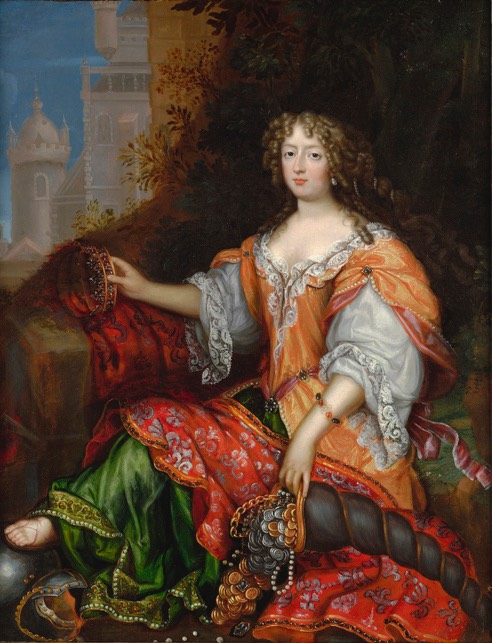
This second attempt never took place, because, due to a tier of arrests, the Parisian Police became aware of the underground circle of poisoners and self-proclaimed magicians.
Already in 1675, the Marquise de Brinvilliers had been arrested for having conspired with her lover, Godin de Sainte-Croix, to poison her father Antoine Dreux d’Aubray in 1666, and in 1670 two of her brothers, Antoine d’Aubray and François d’Aubray, in order to inherit their estates. The Marquise fled, but was arrested and confessed while being tortured, then sentenced to be beheaded and burned.
Magdelaine de La Grange, a colleague of la Voisin, was arrested in 1677 for poisoning. Her speciality was to tell clients, who were worried about their health, that they had been poisoned and to offer them antidotes. She claimed that she had information about crimes of high importance and was kept without trial for months for questioning, but never revealed anything of real importance, however, and was sentenced to death.
Marie Bosse, dite La Bosse, and her friend Marie Vigoreux, the wife of a dressmaker, were arrested in January 1679. La Bosse was one of the most successful fortune tellers in Paris and a self-proclaimed witch. By the end of 1678, Bosse attended a party held by her friend Marie Vigoreaux in the Rue Courtauvilain. During this party, she got so drunk that she started to boast freely of how she managed to become so wealthy, by selling deadly poisons to members of the aristocracy, and how she soon would be able to retire.
At this time, the Parisian Police was already investigating poison sales in Paris and a guest at the party, the lawyer Maitre Perrin, reported the conversation to the police. The wife of a police officer was sent to Bosse to ask for poison to murder her husband and Bosse provided her with what proved to be deadly poison. She was arrested with her daughter Manon and her sons, Francois and Guillame. Her older son was a soldier in the Royal Guard, the younger one was recently released from a working house.
According to the report, when the family was arrested, they were found in the only bed in the house and had committed incest. Marie Vigoreaux was arrested the same day, and was found to have close ties to the family, as she had sexual relations with all of the members of the family. Their confessions revealed that the illegal sale of poison in the capital was handled by a network of fortune tellers. Marie Vigoreux died during interrogation. Marie Bosse was condemned to death by burning and executed in Paris on 8 May 1679. Her children and associates were also sentenced to death.
Leaving Notre-Dame de Bonne-Nouvelle on March 12, 1679, la Voisin was arrested on the way to her meeting with Catherine Trianon. Her long time enemy Marie Bosse spilled the beans on her. La Voisin hinted, to save her skin and postpone her sentence, that important individuals of the court used her services frequently. Her maid Margot hinted how the arrest would mean the end of a number of people of all positions of society. The police made further inquiries. Marguerite Monvoisin, Catherine’s daughter, was questioned thus and Guibourg, Lesage, Bertrand, Romain and the rest of her network of her associates arrested.

On 27 December 1679, Louis XIV issued an order that the whole network should be exterminated regardless of the rank, gender or age of those involved, unknowing that is own mistress was involved.
La Voisin confessed to the crimes she was accused of and described the development of her career. She was never subjected to torture. A formal order was issued giving permission to the use of torture, but it was made clear that the order was not to be put in effect, and consequently it was never made use of. Maybe because she might give away the names of influential people if she was questioned under torture.
La Voisin never mentioned the names of any of her clients during the interviews. She once mentioned to the guards, that the question she feared most, was about her visits at the royal court. It is likely that she was referring to Montespan as her client and her attempt of murdering the King, and that she feared that such a confession should result in her execution for regicide. Her list of clients, the arranging of the black masses, her connection to Montespan and the murder attempt on the King was not to be revealed until after her death, when it was stated by her daughter and confirmed by the uncontaminated testimonies of the other accused.
La Voisin was convicted of witchcraft and was burned in public on the Place de Grève in Paris the 22 February 1680. In August and July 1680, after the execution of her mother in February, Marguerite Monvoisin made a confession which revealed her mother’s list of clients, her connection to Madame de Montespan and the attempted murder of the Monarch. Around the same time, Adam Lesage made his confession, which added that child sacrifices had taken place during the black masses arranged by La Voisin. On 1 October, Françoise Filastre confirmed Monvoisins statement of Montespan and Lesages statement regarding child sacrifices. The confession involved so many people of high rank that the King ordered the official investigation to be closed.
On 9 October, Marguerite Monvoisin confirmed the statement of child sacrifice made by Lesage and Filastre, followed by the confirmation of Étienne Guibourg on October 10. The statements of Marguerite Monvoisin were considered vital, in particular as she was not accused to have taken part in any crime personally, but was exclusively a witness. The remaining members of the organisation were never put on trial, but incarcerated for life by lettre de cachet, and their confessions were sealed.
Étienne Guibourg, Louis Galet, Adam Lesage and Romani were incarcerated at the Château de Besançon. Betrand at the Château de Salces. Marguerite Monvoisin, together with her mother’s female associates La Pelletière, La Poulain, Magdelaine Chapelain, Marguerite Delaporte and Catherine Leroy, were imprisoned at Belle-Île-en-Mer.
It was ordered that the female prisoners from the Poison Affair should be guarded by women to prevent that they use their sexuality to escape. Unlike their male accomplices, the women were not to be chained as long as they behaved well. In January 1687, the women at Belle-Île-en-Mer were granted the use of braziers in midwinter. All the prisoners were condemned to silence and their guards informed that they tend to be habitual liars about Madame de Montespan.
Several members of the nobility were forced to leave France, either by fleeing or being exiled, some were even imprisoned. Whether she was actually involved in the matter to such a degree as stated by Marguerite Monvoisin or not, Madame de Montespan never regained her influence over the King, she had lost his trust, but to keep the facade up and the scandal in chains, the King continued to visit her regularly.
